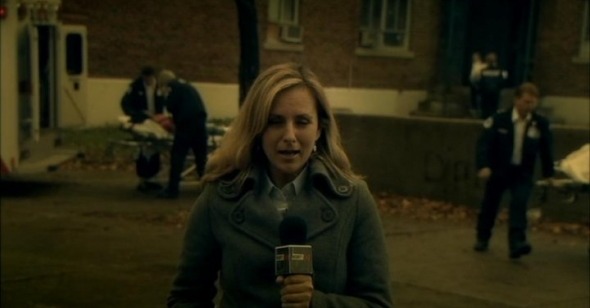Shooting the Messenger
By Michael Koresky
Diary of the Dead
George A. Romero, U.S., Dimension Films
There’s a tendency in some high and low circles to instantly enshrine any new work from classic horror-meister George A. Romero, good-natured, jocular guy that he is, as a way of validating not only his formidable zombie oeuvre but also the seventies horror movie canon itself. Always the most overt of that bunch in his penchant for toothy sociopolitical commentary, Romero has often traded in rather glib social satire since the revelation of his 1978 Dawn of the Dead; whereas Tobe Hooper and John Carpenter’s genre work has mostly been greeted with retrospective praise and analysis, Romero’s never made any bones about his intent. His easy-to-bottle concepts have always had a clever ring—the pop-allegorical purity of brain-devouring zombies shambling through a shopping mall was a great idea waiting to happen. The pitch for the latest incarnation of his series of pre-apocalyptic undead films, Diary of the Dead, in which he has a group of nattering film-schoolers wielding cameras to capture the mayhem as it unfolds, is likewise, a no-brainer.
Yet as smartly staged, and even emotionally tender as it often is, Romero’s latest, with its central and oft-repeated mistrust of the “new information age,” also can’t help but seem a little like the product of aged paranoia—like your pissed-off grandpa, a little preachy and slightly doddering. By now, criticism of twenty-four-seven news cycles, the rapidity of internet communication, and the impossibility of gleaning truth amidst so much unreality, is simply by the book, a dire prognostication of information cataclysm blind to the prospects of new forms of community building, and which does little more than demonize contemporary young filmmakers as (yawn) cannibalistic voyeurs. When one character brags about his MySpace-posted zombie footage getting, improbably, 72,000 hits in eight minutes, we’re supposed to be aghast at his braggadocio (as if posting footage on YouTube or elsewhere has anything to do with craving fame) and bemused at how plugged-in our generation is, as opposed to relieved that such high numbers people out there are trying to make contact.
At the same time, Diary of the Dead, antiquated though it may be in its oddly negating mix of new technologies and its 67-year-old director’s fear of them, is unmistakably the product of a savvy, sassy mind in on its own joke. For every moralizing pit stop (and there are many) there’s an expertly modulated set piece, balanced between the cerebral and the cheeky, that confirms Romero still excels at highlighting the occasional crudeness of his own commentary. (An interlude with a surprisingly resourceful Amish gent, unburdened by technology though he may be, expertly utilizes the handheld camerawork for prime comic oomph.)
Despite his anger, Romero has fun with his central technical conceit, not to mention his self-proclaimed return to his independent roots: his film is meant as a reconstruction of the retrieved video footage of a film student run amok with auteurist power in an attempt to document his zombie-strewn road trip, accompanied by girlfriend Debra (Michelle Morgan) and a handful of other privileged white kids from his movie crew. The director is one Jason Creed, rarely shown on camera, and his final cut has been titled, amusingly, “The Death of Death.” Technically not even a film within the film, “The Death of Death” simply is the movie we’re watching, assembled with additional downloaded videos, and images from surveillance and cell-phone cameras. Romero’s impish glee at pretending to cede directorial authority to a selfish jerk-off filmmaker is infectious enough to make one overlook the overly deliberate mise-en-scene, mightily rehearsed performances, and always suspiciously crystalline sound design that work against his rigorously ramshackle conception. (De Palma ran into similar narrative problems with Redacted, which negotiated with reality and unreality, while also toying with methods of information dissemination.) What its obvious antecedent, The Blair Witch Project lacked in finesse, it more than made up for in sticking to its aesthetic guns and playing audaciously with what could and could not be captured within the frame. Often Diary of the Dead, with its artfully bronzed images and vivid gore, seems like a traditionally designed and executed scare machine that just happens to be framed through a shaky viewfinder.
And like Blair Witch, the narrative has to belabor the rationale why any reasonable human would keep filming under such extreme duress. The answer, of course, explicitly stated by characters in Diary and Blair Witch, is that the camera provides a filter for reality, lending the filmmaker the personage of a war photographer. It’s a directorial positioning at once self-aggrandizing and self-deprecating, and the moral doomsday sentiments grow wearying (its final sad question to the audience is more forced than forceful). Though Romero keeps things visually fresh, it’s hard not to feel that his once razor-sharp satire too often tips over into pedantic haranguing. But we should at least be pleased that there’s still some life left in these Dead things.
